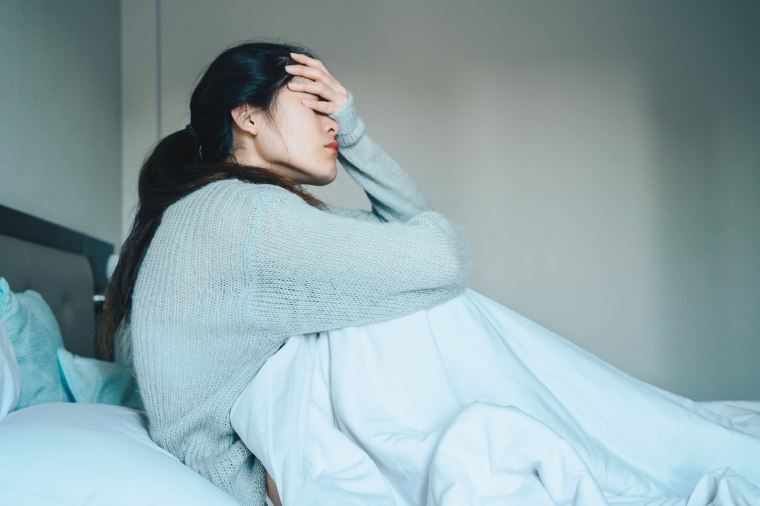While rates of COVID-19 remain high across the country, flu clusters are beginning to pop up as well. And with both illnesses spreading, the possibility of getting a co-infection involving both of them — nicknamed "flurona" — is also becoming more of a possibility.
In fact, a woman was released from an Israeli hospital just this week after being infected with both COVID-19 and the flu. Although she had mild symptoms, she was pregnant and unvaccinated, according to a report in the Times of Israel. And co-infections like these have been reported in the U.S. as early as spring 2020.
Thankfully, the risk of developing infections like these is rare. But the possibility is all the more reason to protect yourself — from both viruses.
The omicron surge continues while the flu is picking up steam.
"COVID rates have never been worse in our area and for much of the country," Dr. Costi Sifri, director of hospital epidemiology at UVA Health, told TODAY.
That's largely fueled by the emergence of the omicron variant on top of delta COVID-19 cases that were already spreading, Eili Klein, associate professor in the department of emergency medicine at Johns Hopkins University School of Medicine, told TODAY.
"If you add the prospect of flu to the mix, that can only exacerbate what is already a very, very challenging situation in health care particularly for us in general," Sifri said.
While the last flu season was mild, some states are seeing rising rates of influenza right now while others aren't, which is unusual in a different way, Klein explained. "Normally this is actually the peak where much of the country is starting to see high rates of flu," he said, noting that behavioral changes in response to rising COVID-19 cases — wearing masks again, avoiding crowds — might be helping to prevent the spread of flu in some areas.
According to the Centers for Disease Control and Prevention, certain areas of the country are seeing more transmission than others. States such as New Jersey, Georgia and North Dakota are experiencing very high levels of flu-like illness as of the week ending Dec. 25, according to the most recent CDC data available. Virginia, New York, South Carolina and Florida are also seeing high amounts of transmission right now.
Hospitalizations due to flu are increasing as well, the CDC said.
Rather than a "twindemic" of both COVID-19 and flu cases peaking at the same time, Klein expects to see the current omicron-fueled wave subside and a subsequent peak of flu cases in the coming weeks.
Can you get COVID-19 and the flu at the same time?
Yes, it is possible to become infected with both viruses at the same time, the experts said.
But, to be clear, that does not mean that the viruses are somehow combining in your body to become one superinfection. A "flurona" infection is simply having both individual viruses at the same time.
So far, co-infections like these have been rare, Klein explained. And experts don't know enough yet to say whether or not having both infections at once necessarily means you'll have more severe symptoms.
Testing presents challenges for monitoring co-infections
"The problem is always that it's actually somewhat difficult to determine if it's a true co-infection," Klein said.
For one thing, some people may test positive for COVID-19 on PCR tests long after they actually have the infection — sometimes for weeks or months. So someone who tests positive for COVID-19 and the flu might have actually already recovered from COVID-19 and just have the flu, Sifri said. "It's something that we may end up seeing and having a challenging time sorting out."
That scenario is most likely to happen if you get tested at a hospital, where PCR samples are routinely tested for multiple viral illnesses at once. Outside of a hospital, those types of panels are rare because they tend to be more expensive, Klein said.
In other medical settings, there may not be the capacity for that type of testing and, therefore, it may be harder to pick up co-infections. Doing a rapid antigen test, for instance, requires you to test for one virus at a time. So if you present with flu-like symptoms and test positive for COVID-19, your doctor may not necessarily decide to test you for something else on top of that.
In many cases, deciding which infections to test you for comes down to your health care provider's discretion. They'll take your specific combination of symptoms into account as well as information about what illnesses are circulating in your local area. And if they know you're in a part of the country with flu and COVID-19 spiking right now, "a physician may make the decision to test for both," Sifri said.
What should you do if you get "flurona"?
For people who are otherwise generally healthy, a flu and COVID-19 co-infection isn't necessarily going to be a severe one.
Consult with your health care provider and follow general home care advice for both illnesses, Sifri said. That includes staying hydrated, getting plenty of rest and managing any fever or body aches with over-the-counter pain medications. If you have any underlying factors that put you at a higher risk for severe symptoms of COVID-19 or the flu, your provider may prescribe an antiviral medication for flu or monoclonal antibodies for COVID-19.
Be sure to also follow public health guidelines for quarantining and keeping those around you safe. And, of course, if you experience severe symptoms such as trouble breathing or a high fever that isn't responding to medication, you should seek medical attention.

